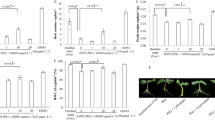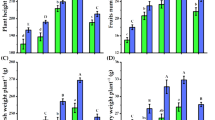Abstract
The objective of this study was to investigate the effect of salinity on growth, fatty acid composition, phenol content and antioxidant activity of Nigella sativa organs. Plants were grown hydroponically under NaCl stress (0, 20 40 and 60 mM). The results indicated that salinity affected N. sativa growth. The fatty acid composition of the leaves and the roots was investigated for the first time and major fatty acids were linolenic acid (58.1%) in the leaves and linoleic (43.9%) and palmitic (33.3%) acids and in the roots. Total fatty acid (TFA) content of the leaves decreased at 60 mM NaCl while root TFA increased at 20 and 40 mM NaCl. Moreover, the fatty acid composition was affected by NaCl; in leaves, the double bond index (DBI) decreased accompanied by a decrease of the level of linolenic acid which reached 14% at 60 mM NaCl. However, root DBI degree increased at 40 at 60 mM NaCl provoked mainly by the increase of the amount of linoleic acid by 15 and 8%, respectively, and the decrease of the amount of palmitic acid by 20 and 14%, respectively. Salt stress increased total polyphenol and individual phenolic acid contents in shoots. Moreover, the antiradical activity of the shoots (DPPH) increased at 60 mM NaCl. However, in roots, the total polyphenol content and the antiradical activity decreased sharply with increasing NaCl doses. Data reported here revealed the variation of fatty acids and phenolic compound contents in different organs of N. sativa, and the possible role of theses changes in the plant salt response were discussed.


Similar content being viewed by others
References
Aidi Wannes W, Mhamdi B, Marzouk B (2009) Variations in essential oil and fatty acid composition during Myrtus communis var. italica fruit maturation. Food Chem 112:621–626
Aso T, Hasegawa K, Sueda Y, Tomita K, Taniguchi K, Hosoki T, Pramanik MHR, Matsui Y (2003) Autotoxicity of root exudates from taro. Sci Hort 97:389–396
Baldini M, Giovanardi R, Tahmasebi-Enferadi S, Vannozzi GP (2002) Effects of water regime on fatty acid accumulation and final fatty acid composition in the oil of standard and high oleic sunflower hybrids. Ital J Agron 6:119–126
Ben Taarit M, Msaada K, Hosni K, Marzouk B (2010) Changes in fatty acid and essential oil composition of sage (Salvia officinalis L.) leaves under NaCl stress. Food Chem 119:951–956
Bettaieb I, Hamrouni-Sellami I, Bourgou S, Limam F, Marzouk B (2011) Drought effects on polyphenol composition and antioxidant activities in aerial parts of Salvia officinalis L. Acta Physiol Plant 33:1103–1111
Bligh EG, Dyer WJ (1959) A rapid method of total lipid extraction and purification. Can J Biochem Physiol 37:911–917
Borsani O, Valpuesta V, Botella MA (2001) Evidence for a role of salicylic acid in the oxidative damage generated by NaCl and osmotic stress in Arabidopsis seedlings. Plant Physiol 126:1024–1030
Bourgou S, Ksouri R, Bellila A, Skandrani I, Falleh H, Marzouk B (2008) Phenolic composition and biological activities of Tunisian Nigella sativa L. shoots and roots. C R Biol 133:48–55
Bourgou S, Pichette A, Marzouk B, Legault J (2010) Bioactivities of black cumin essential oil and its main terpenes from Tunisia. S Afr J Bot 76:210–216
Burchard P, Bilger W, Weissenbock G (2000) Contribution of hydroxycinnamates and flavonoids to epidermal shielding of UV-A and UV-B radiation in developing rye primary leaves as assessed by ultraviolet-induced chlorophyll fluorescence measurements. Plant Cell Environ 23:1373–1380
Cecchi G, Biasini S, Castano J (1985) Méthanolyse rapide des huiles en solvants. Note de laboratoire. Rev Franc Corps Gras 4:163–164
Cheikh-Rouhou S, Besbes S, Hentati B, Blecker C, Deroanne C, Attia H (2007) Nigella sativa L.: chemical composition and physicochemical characteristics of lipid fraction. Food Chem 101:673–681
Cramer GC, Lauchli A, Polito VS (1985) Displacement of Ca2+ by Na+ from the plasmalemma of root cells: a primary response to salt stress? Plant Physiol 79:207–211
Dixon RA, Paiva NL (1995) Stress-induced phenylpropanoid metabolism. Plant Cell 7:1085–1097
Edreva A (2005) The importance of non-photosynthetic pigments and cinnamic acid derivatives in photoprotection. Agr Ecosys Environ 106:135–146
Elzaawely AA, Xuan TD, Tawata S (2007) Changes in essential oil, kava pyrones and total phenolics of Alpinia zerumbet (Pers.) BL Burtt and RM Sm. leaves exposed to copper sulphate. Env Exp Bot 59:347–353
Foyer H, Descourvierse P, Kunert KJ (1994) Protection against oxygen radicals: an important defense mechanism studied in transgenic plants. Plant Cell Environ 17:507–523
Francois LE, Kleiman R (1990) Salinity effects on vegetative growth, seed yield and fatty acid composition of crambe. Agron J 82:1110–1114
Gignon S, Matos AR, Laffrad Y, Zuily Fodil Y, Pham Thi AT (2004) Effect of drought stress on lipid metabolism in the leaves of Arabidopsis thaliana (Ecotype Columbia). Ann Bot 94:345–351
Hachicha M (2007) Les sols salés et leur mise en valeur en Tunisie. Sécheresse 18:45–50
Hanato T, Kagawa H, Yasuhara T, Okuda T (1988) Two new flavonoids and other constituents in licorice root their relative astringency and radical scavenging effect. Chem Pharm 36:1090–1097
Hasegawa PM, Bressan RA, Zhu JK, Bohnert HJ (2000) Plant cellular and molecular responses to high salinity. Annu Rev Plant Physiol Plant Mol Biol 51:463–499
Hoagland DR, Arnon DI (1950) The water culture method for growing plants without soil. Circ 347, Calif Agric Exp Sta, USA, California, Berkley
Hussain K, Majeed A, Nawaz K, Hayat KB, Nisar MF (2009) Effect of different levels of salinity on growth and ion contents of black seeds (Nigella sativa L). Curr Res J Biol Sci 1:135–138
Kamisaka S, Takeda S, Takahashi K, Shibata K (1990) Diferulic and ferulic acid in the cell wall of Avenacoleoptiles: their relationships to mechanical properties of the cell wall. Physiol Plant 78:1–7
Kerkeb L, Donnaire JP, Venema K, Rodriguez-Rosales MP (2001) Tolerance to NaCl induce changes in plasma membrane lipid composition, fluidity and H + -ATPase activity to tomato calli. Physiol Plantarum 113:217–224
Kovacik J, Klejdus B, Backor M, Repcak M (2007) Phenylalanine ammonia-lyase activity and phenolic compounds accumulation in nitrogen-deficient Matricaria chamomilla leaf rosettes. Plant Sci 172:393–399
Kuiper PJC (1984) Functioning of plant cell membranes under saline conditions: membrane lipid composition and ATPase. In: Staples RC, Toemmiessen GH (eds) Salinity tolerance in plants: strategies for crop improvement. Wiley, New York
Lopez-Perez L, Martínez-Ballesta MC, Maurel C, Carvajal M (2009) Changes in plasma membrane lipids, aquaporins and proton pump of broccoli roots, as an adaptation mechanism to salinity. Phytochem 70:492–500
Luttge U (1993) Plant cell membranes and salinity: structural, biochemical and biophysical changes. R Bras Fisiol Veg 5:217–224
Macheix JJ, Fleuriet A, Jay-Allemand C (2005) Les composés phénoliques des végétaux. Un exemple de métabolites secondaires d’importance économique. Presses polytechniques et universitaires romandes. Lausanne
Mahajan S, Tuteja N (2005) Cold, salinity and drought stresses: an overview. Arch Biochem Biophys 444:139–158
Mansour MMF, Salama KHA (2004) Cellular basis of salinity tolerance in plants. Environ Exp Bot 52:113–122
Mazliak P (1968) Le métabolisme des lipides dans les plantes supérieures. Masson et Cie. Ed., Paris
Mongrand S, Bessoule JJ, Cabantous F, Cassagne C (1998) The C16: 3/C18: 3 fatty acid balance in photosynthetic tissues from 468 plant species. Phytochem 49:1049–1064
Munns R (2002) Comparative physiology of salt and water stress. Plant Cell Environ 25:239–250
Navarro JM, Flores P, Garrido C, Martinez V (2006) Changes in the contents of antioxidant compounds in pepper fruits at different ripening stages, as affected by salinity. Food Chem 96:66–73
Neffati M, Marzouk B (2009a) Changes in essential oil and fatty acid composition in coriander (Coriandrum sativum L.) leaves under saline conditions. Ind Crop Prod 29:657
Neffati M, Marzouk B (2009b) Roots volatiles and fatty acids of coriander (Coriandrum sativum L.) grown in saline medium. Acta Physiol Plant 31:455–461
Oh MM, Trick HN, Rajashekar CB (2009) Secondary metabolism and antioxidants are involved in environmental adaptation and stress tolerance in lettuce. J Plant Physiol 166:180–191
Oueslati S, Karray-Bouraoui N, Attia H, Rabhi M, Ksouri R, Lachaal M (2010) Physiological and antioxidant responses of Mentha pulegium (Pennyroyal) to salt stress. Acta Physiol Plant 32:289–296
Posmyk MM, Kontek R, Janas KM (2009) Antioxidant enzymes activity and phenolic compounds content in red cabbage seedlings exposed to copper stress. Ecotox Environ Safe 72:596–602
Quartacci MF, Pinzino C, Sgherri CLM, Dalla Vecchi F, Navari-Izzo F (2000) Growth in excess copper induces changes in the lipid composition and fluidity of PSII-enriched membranes in wheat. Physiol Plant 108:87–93
Rie De Vos CH, Ten BWM, Voojis R, Schat H, Deko LJ (1993) Effect of copper on fatty acid composition and peroxydation of lipids in the roots of copper tolerant and sensitive Silene cucubalus. Plant Physiol Biochem 31:151–158
Sampietro DA, Vattuone MA, Isla MI (2006) Plant growth inhibitors isolated from sugarcane (Saccharum officinarum) straw. J Plant Physiol 163:837–846
Takaham U (2004) Oxidation of vacuolar and apoplastic phenolic substrates by peroxidase: physiological significance of the oxidation reactions. Phtochem Rev 3:207–219
Wakabayashi K, Hoson T, Kamisaka S (1997) Osmotic stress suppresses cell wall stiffening and the increase in cell wall-bound ferulic and diferulic acids in wheat coleoptiles. Plant Physiol 113:967–973
Xie Z, Duan L, Tian X, Wang B, Eneji AE, Li Z (2008) Coronatine alleviates salinity stress in cotton by improving the antioxidative defense system and radical-scavenging activity. Plant Physiol 165:375–384
Zhang M, Barg R, Yin M, Gueta-Dahan Y, Leikin-Frenkel A, Salts Y, Shabtai S, Ben-Hayyim G (2005) Modulated fatty acid desaturation via overexpression of two distinct ω-3 desaturases differentially alters tolerance to various abiotic stresses in transgenic tobacco cells and plants. Plant J 44:361–371
Author information
Authors and Affiliations
Corresponding author
Additional information
Communicated by W. Filek.
Rights and permissions
About this article
Cite this article
Bourgou, S., Bettaieb, I., Hamrouni, I. et al. Effect of NaCl on fatty acids, phenolics and antioxidant activity of Nigella sativa organs. Acta Physiol Plant 34, 379–386 (2012). https://doi.org/10.1007/s11738-011-0836-3
Received:
Revised:
Accepted:
Published:
Issue Date:
DOI: https://doi.org/10.1007/s11738-011-0836-3




